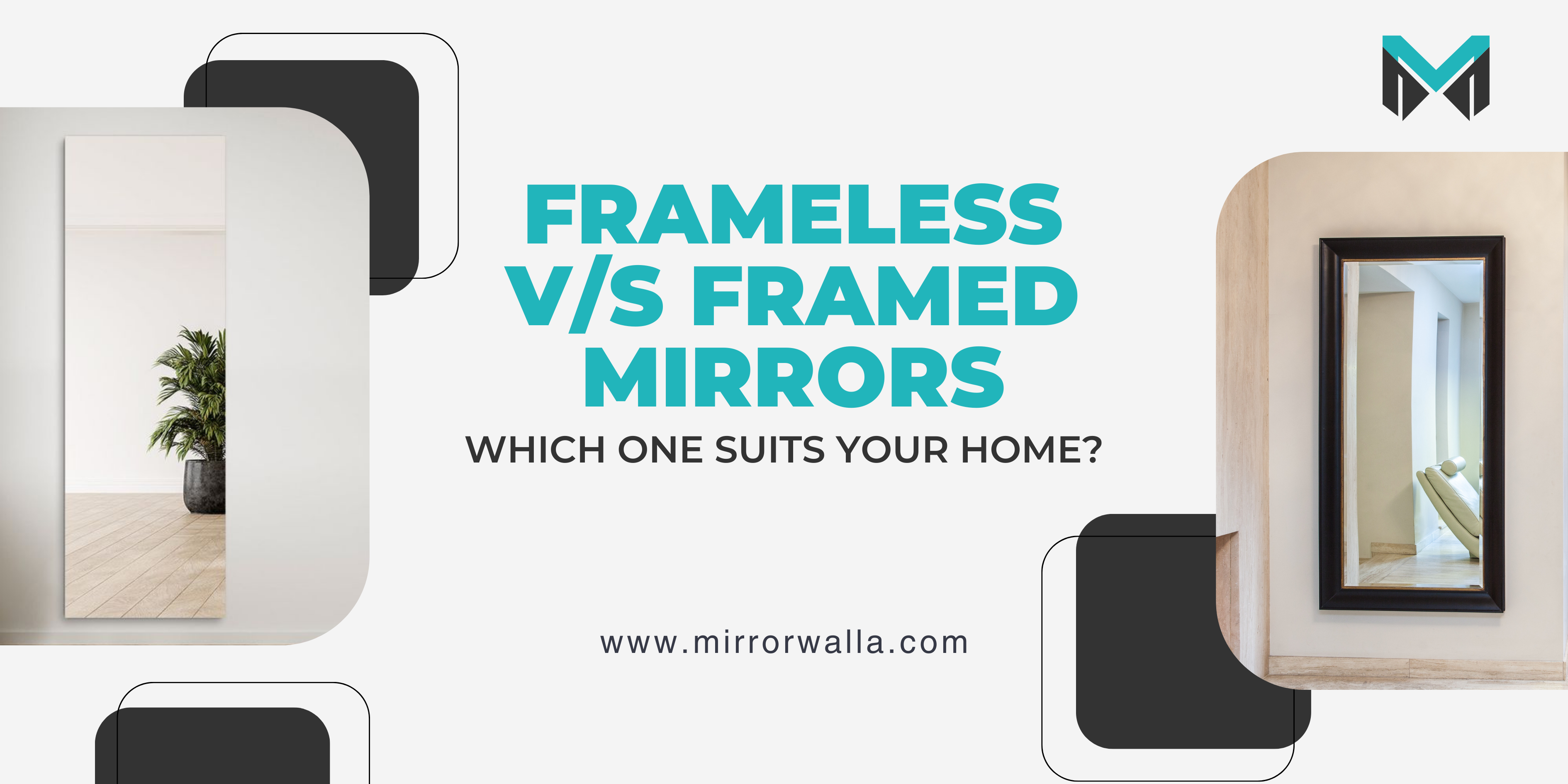Mirrors are powerful decorative tools that may totally change the sense and use of your space. They are not only reflecting surfaces, mirrors are quite essential in determining your interior, whether your bathroom is being rebuilt, a corridor is being updated or you want some extra touch in your living room. But one of the most important considerations you will have to make regarding the appropriate mirror is whether to go with a framed or frameless one.
Frameless and framed mirrors are among the most often used forms. Which one would be ideal for your house? We will explore the main variations, advantages, and design features of each type in this blog to help you decide whether a black-framed mirror, a frameless mirror, or a high-tech LED mirror would be the best fit for your area.
Understanding The Basic Differences:
A Framed Mirror:
A framed mirror is exactly what it sounds like, a mirror with a structural or decorative border either thick or thin all around. From rustic to ultra modern, frames can be built of good quality wood, metal, plastic, or composite materials and incorporate an amazing range of styles.
A Frameless Mirror:
Conversely, a frameless mirror has no frame or border. Basically, it’s a sheet of mirror glass with a polished or beveled edges. Usually found in bathrooms, halls, of modern homes, frameless mirrors offer a simple, uncluttered look.
Advantages And Disadvantages Of Framed Mirrors:
Pros –
1. Design Flexibility:
Framed mirrors provide a fantastic range of styles to match different spaces. Frames to match your rustic farmhouse, modern glamour, classic, or boho style taste are there. Matching with your furniture and color of walls in the house becomes easier this way.
2. Adds visual appeal:
Frames, serves as a focal point in the room, can be compared to paintings or artworks, giving personality to your mirror. The overall look of the room can be enhanced by the frame’s intricately detailed patterns, hues, and textures.
3. Edges’ Protection
Serving as a buffer, the frame shields the mirror’s edges from chipping or cracks. In houses with children or in high-traffic areas, this can especially help.
Cons –
1. May be bulky:
Especially in understated or compact spaces, framed mirrors may become heavy or too ornamental. The frame provides visual and physical weight which may not be always the preferred one.
2. Higher cost (sometimes):
A framed mirror might be more expensive depending on craftsmanship and high quality material. Custom frames or high-end materials such as brass can increase costs further.
3. More challenging over time to match:
If you replace furniture or update them, a framed mirror that complemented your decoration previously might no longer match your style due to refurnishing.
Advantages And Disadvantages Of Frameless Mirrors.
Pros –
1. Sleek, modern look
Minimalistic, modern, or industrial looks require frameless mirrors. Their tidy and uncluttered look can make small spaces look larger and lighter.
2. Flexible placement
Bathrooms and bedrooms to hallways and dining rooms, frameless mirrors fit in everywhere without a decorative frame to keep them fixed in one style.
3. Often More Reasonably Cost
Typically less expensive than their framed counterparts, frameless mirrors do not have the additional material and craftsmanship required for a frame.
4. Simple Cleanliness
Fewer grooves and surfaces for dust and dirt to accumulate due to no frame. A quick wipe-down maintains the mirror spotless.
Cons –
1. Less Impactful as Decor:
A frameless mirror might look either too functional or boring. A frameless style might not be enough alone if you prefer your mirror to make a big style statement.
2. Open Edges:
While most frameless mirrors feature polished or beveled edges, they are still more likely to chip—especially at installation or shipping.
3. Could Require Special Mounting:
Some frameless mirrors require special clips or adhesive mounts, which may be more challenging to install than simply hanging a hook-mounted framed mirror.
Appropriate Locations For Best Framed VS. Frameless Mirror:
Let’s discuss which mirror style would fit various parts of your house.
- FOR BATHROOM:
FRAMED MIRROR: Framed mirror is great for classic or vintage-style bathrooms. A black-framed mirror will contrast your vanity area elegantly and frame it.
FRAMELESS MIRROR: A frameless mirror is perfect for sleek or understated bathrooms. It keeps the space feel open and spacious and reflects more light.
LED MIRROR: LED mirror is perfect for shaving and makeup. It blends a little luxury with utility.
- FOR LIVING ROOM:
FRAMED MIRROR: Above a fireplace or console table, use a framed mirror in the living room as a decorative focal point. Make sure your frame accentuates your furniture.
FRAMELESS MIRROR: Perfect for minimalist interior design or gallery-style walls. Cleanses the space from visual clutter.
- BEDROOM:
FRAMED MIRROR: A framed mirror in the bedroom lends warmth and style. Against light walls or wooden furniture, a black-framed mirror will look beautiful.
FRAMELESS MIRROR: Useful for full-length dressing mirrors is a frameless mirror. Presents a modern, understated appearance.
- ENTRYWAY:
FRAMED MIRROR: At your entryway framed mirror shapes the atmosphere of the house. Create a strong first impression with striking design.
LED MIRROR: For evening arrivals, the LED mirror adds mood lighting and utility.
CONCLUSION:
There is no one-size-fits-all answer. While framed mirrors provide character and personality to your room, where as uncluttered elegance and modern appeal are provided by frameless mirrors. Your own taste, the interior design of your home, and the purpose of the area will all influence your decision.
Therefore, there is a great mirror collection out there at Mirrorwalla ready to reflect your style regardless of your inclination toward classic appeal or elegant simplicity.

